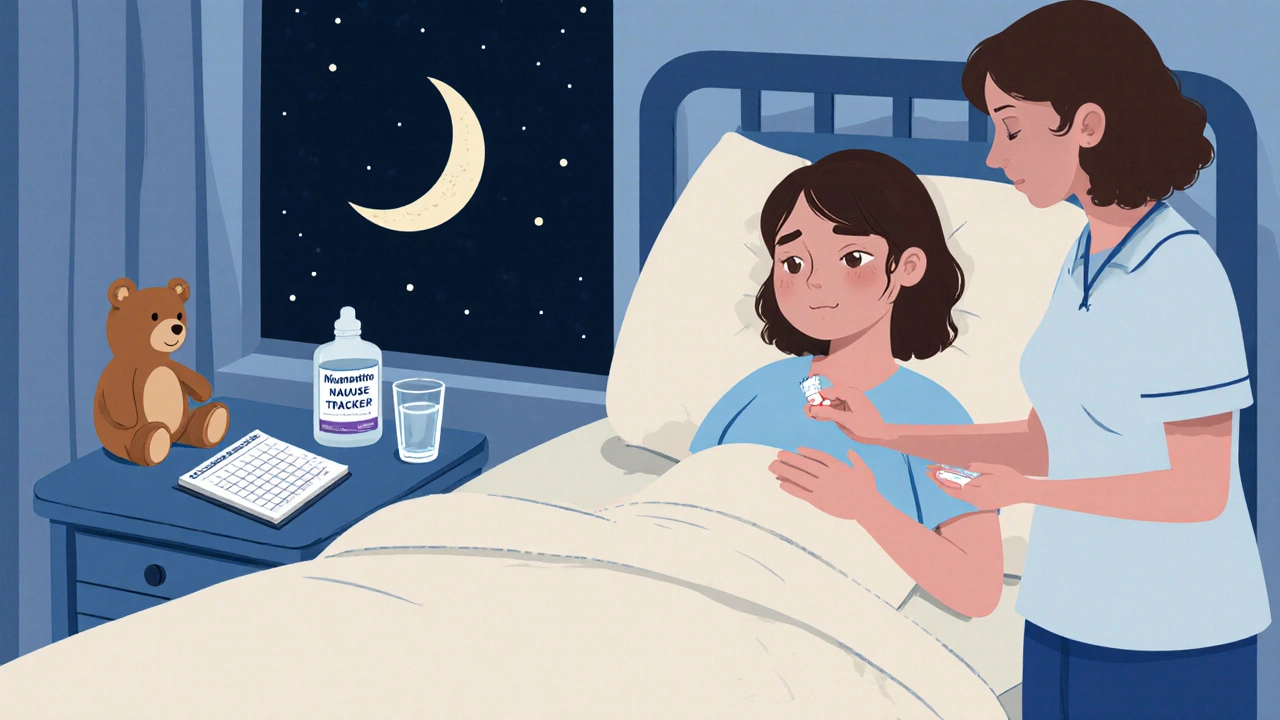Over two-thirds of pregnant women experience nausea and vomiting - not just in the morning, but all day, every day. For many, it’s more than an inconvenience; it’s debilitating. You can’t keep food down, you’re exhausted, and the thought of eating makes you sick. When lifestyle changes and ginger don’t cut it, medication becomes necessary. But what’s actually safe? And what could put your baby at risk?
First-Line Treatments: What Works and Why It’s Safe
The gold standard for treating nausea in pregnancy starts with two simple things: vitamin B6 and doxylamine. Together, they form the basis of Diclegis, the only FDA-approved medication specifically for pregnancy-related nausea. Pyridoxine (vitamin B6) at 25 mg three times a day, plus doxylamine 25 mg at bedtime, works for most women. Studies show it’s significantly better than placebo - and no link to birth defects has ever been proven at these doses.
Why is this combo trusted? Because it’s been studied for decades. The American College of Obstetricians and Gynecologists (ACOG) recommends it as the first real medication option after diet and ginger. It doesn’t cross the placenta in harmful amounts, and decades of use in millions of pregnancies show no increase in miscarriage, preterm birth, or major malformations. The most common side effect? Drowsiness. That’s why it’s taken at night. Many women say they can finally sleep - and eat breakfast - for the first time in weeks.
Ginger is another first-line option. ACOG and multiple meta-analyses confirm it’s as effective as B6 for reducing nausea. Take 250 mg four times a day in capsule form. One study found ginger reduced nausea by 79% compared to placebo. It doesn’t cause drowsiness, doesn’t interact with other meds, and has no known fetal risks. The downside? Some people hate the taste. If capsules are too strong, try ginger tea or crystallized ginger - just make sure it’s real ginger, not flavoring.
Antihistamines: The Quiet Workhorses
If B6 and ginger don’t help enough, antihistamines step in. Meclizine (Antivert), dimenhydrinate (Dramamine), and diphenhydramine (Benadryl) are all safe and effective. Dosing is usually 25-50 mg every 4-6 hours as needed. These were once feared as dangerous, but large studies have cleared them. In fact, meclizine was once thought to cause cleft palate - until researchers looked at 10,000 pregnancies and found no link.
Dimenhydrinate works fast and is often used in emergency rooms for severe vomiting. But it can make you feel foggy or dizzy. Diphenhydramine helps with nausea and can also improve sleep - useful if nausea is keeping you awake. All three are available over the counter and cost far less than prescription options. Many OB-GYNs in Australia and the U.S. still recommend them as second-line choices, especially when Diclegis isn’t covered by insurance.
The Risky Ones: Ondansetron, PPIs, and Steroids
Ondansetron (Zofran) is popular. It’s powerful. It stops vomiting fast. But it’s also the most controversial.
A 2012 NIH study of over 4,500 pregnancies found a 2.37 times higher risk of cerebral palsy in babies whose mothers took ondansetron during the first trimester. That’s not a small number. It doesn’t mean every baby exposed will be affected - the absolute risk is still low - but it’s enough to make experts cautious. Some doctors still prescribe it for women with hyperemesis gravidarum who are losing weight and dehydrated. But it’s no longer first- or even second-line. It’s third-line - only when everything else fails.
Other risks come from unexpected places. Proton pump inhibitors (PPIs) like omeprazole are often used for heartburn, which can mimic or worsen nausea. But research shows they’re linked to a 4.36 times higher risk of hypospadias - a condition where the urethra doesn’t form correctly in male babies. That’s a big red flag. If you’re taking omeprazole for heartburn, talk to your doctor. Antacids with calcium carbonate are safer and may even lower the risk of cleft lip or palate.
Corticosteroids like prednisone are sometimes used for extreme, unrelenting nausea. But they carry a 3.4-fold increased risk of oral clefts. That’s why they’re reserved for cases where hospitalization is needed and nothing else works. Even then, most hospitals avoid them unless absolutely necessary.

What About Acupressure, Wristbands, and Other Alternatives?
You’ve probably seen those wristbands - Sea-Bands, for example. They claim to relieve nausea by pressing on a pressure point. Sounds harmless, right? But the science says otherwise. A 2023 meta-analysis found acupressure had the same effect as placebo. In one study, 41% of women on BabyCenter forums said they didn’t feel any difference. That doesn’t mean they’re dangerous - just that they don’t work better than doing nothing.
Other alternatives like peppermint oil, lemon water, or acupuncture have no strong evidence backing them. Some women swear by them, and if they help without side effects, there’s no harm. But don’t rely on them if your nausea is severe. You need proven treatments, not anecdotes.
Real Stories: What Women Are Saying
On Reddit, over 1,200 pregnant women shared their experiences. Seventy-eight percent said ginger capsules gave them relief - and 62% preferred them to prescription meds because they didn’t make them sleepy. On Drugs.com, users of Diclegis gave it an 84% effectiveness rating, but 67% said drowsiness was a problem. One woman wrote: “I can finally eat breakfast without rushing to the bathroom. But I need a nap by 10 a.m.”
On the other hand, 32% of ondansetron users reported severe headaches, dizziness, or constipation. One woman said: “I stopped it after three days. I felt like I was going to pass out every time I stood up.”
These aren’t isolated cases. They’re patterns. And they matter.
How to Decide: A Simple Step-by-Step Plan
Here’s what works in real clinical practice:
- Start with diet and lifestyle: Eat small, bland meals. Avoid strong smells. Keep crackers by your bed. Drink fluids between meals, not with them.
- Add ginger: 250 mg capsules four times a day. Try for 3-5 days.
- If no improvement, add B6: 25 mg three times daily. You can take it with ginger.
- If still struggling, add doxylamine at night: 25 mg. This combo is Diclegis - and it’s safe.
- If vomiting continues, try an antihistamine: Meclizine or dimenhydrinate during the day. Diphenhydramine at night if sleep is an issue.
- Only if all else fails, consider ondansetron: Under close supervision. Never as a first choice.
Timing matters. Don’t wait until you’re vomiting to take meds. Take them before symptoms peak - like before breakfast or before getting out of bed.

What to Avoid
Don’t self-prescribe. Don’t assume “natural” means safe. Don’t skip your OB’s advice because a blog says so. And don’t feel guilty for needing medication. Nausea isn’t a sign of weakness - it’s a physiological response. Treating it doesn’t harm your baby. Not treating it can.
Severe nausea can lead to dehydration, weight loss, and hospitalization. Studies show early treatment reduces hospital stays by up to 1.8 days. That’s not just comfort - it’s health.
Also, avoid iron-heavy prenatal vitamins in the first trimester. Iron worsens nausea. Switch to an iron-free version until your stomach settles, then restart it. Many women don’t know this trick - but it makes a huge difference.
The Bottom Line
You don’t have to suffer. There are safe, effective options. The key is starting early, using the right tools in the right order, and avoiding the ones with known risks. Diclegis and ginger are your best friends. Antihistamines are reliable backups. Ondansetron, PPIs, and steroids? Use them only when there’s no other choice - and only with your doctor’s full understanding of the risks.
Every pregnancy is different. What works for one woman may not work for another. But the evidence is clear: treating nausea doesn’t endanger your baby. Not treating it might.
Is it safe to take ginger during pregnancy for nausea?
Yes, ginger is considered safe and effective for nausea in pregnancy. Studies show that taking 250 mg of ginger four times daily reduces nausea significantly with no increased risk of birth defects. It’s recommended by ACOG as a first-line non-drug option. Capsules are preferred over tea or candy because they provide consistent dosing.
Can I take Zofran (ondansetron) while pregnant?
Ondansetron is not recommended as a first- or second-line treatment during pregnancy. A major NIH study found a 2.37 times higher risk of cerebral palsy in babies exposed to it in the first trimester. While the absolute risk is low, safer options exist. It should only be used in severe cases of hyperemesis gravidarum when other treatments have failed, and only under close medical supervision.
What’s the difference between Diclegis and taking B6 and Unisom separately?
Diclegis is a delayed-release formula that combines pyridoxine (B6) and doxylamine (the active ingredient in Unisom) in one pill. Taking them separately works just as well - and costs far less. The only difference is timing: Diclegis releases the medication slowly over time, which may help with morning nausea. But many women take 25 mg B6 three times a day and 25 mg doxylamine at bedtime and get the same results.
Are antihistamines like Benadryl safe in early pregnancy?
Yes, antihistamines like diphenhydramine (Benadryl), dimenhydrinate (Dramamine), and meclizine (Antivert) are considered safe in pregnancy. Early fears about birth defects were based on outdated or flawed studies. Large, modern studies show no increased risk of major malformations. They’re often used as second-line treatments after B6 and ginger.
Should I stop taking omeprazole if I’m pregnant and have heartburn?
Omeprazole and other PPIs are linked to a higher risk of hypospadias in male babies - about 4.36 times higher in one major study. If you’re using it for heartburn, switch to calcium carbonate antacids (like Tums) first. They’re safer and may even reduce the risk of cleft lip or palate. If antacids don’t work, talk to your doctor about H2 blockers like famotidine, which have a better safety profile.
Can nausea during pregnancy harm my baby?
Mild to moderate nausea and vomiting do not harm your baby. In fact, some studies suggest it’s linked to a slightly lower risk of certain birth defects like cleft lip and hypospadias. The real danger is when nausea becomes so severe you can’t keep food or fluids down - that’s called hyperemesis gravidarum. Left untreated, it can lead to dehydration, weight loss, and electrolyte imbalances that may affect fetal development. Treating nausea early helps prevent these complications.
Next Steps
If you’re struggling with nausea right now, start with ginger and B6 today. Don’t wait until you’re vomiting every hour. Talk to your doctor about Diclegis or antihistamines if symptoms persist. Avoid ondansetron unless you’ve tried everything else. And if you’re using PPIs for heartburn, switch to Tums - it’s simpler, cheaper, and safer.
Remember: You’re not alone. Eight out of ten pregnant women go through this. And there’s a safe, proven path through it - if you know where to look.


9 Comments
Jeremy Hernandez
So let me get this straight-you’re telling me it’s *safe* to take a drug that’s literally just Unisom and B6, but Zofran is a baby-brain-killer? And you want me to believe the FDA didn’t know this? Please. They approved Zofran for nausea in pregnancy *after* the 2012 study. Someone’s getting paid to keep this quiet. I’ve seen moms on forums who took it and their kids had seizures at age 3. Coincidence? Nah. It’s corporate greed wrapped in ACOG jargon.
Jessica Healey
i just took ginger caps and it made me wanna puke harder lmao. why does it taste like old socks?? i switched to peppermint tea and now i’m not crying every time i smell coffee. also i hate that everyone acts like b6 + unisom is the holy grail-what if you’re allergic to doxylamine? no one talks about that. also why is no one talking about the fact that some prenatal vitamins have like 27mg of b6? i took that and got nerve tingles. nobody warns you.
kora ortiz
You’re not alone. I was vomiting for 14 weeks straight. I thought I was failing as a mom. Then I tried the B6 + doxylamine combo at night and slept for the first time in months. I ate a whole pancake yesterday. I cried. This isn’t just about nausea-it’s about your mental health. If you’re reading this and you’re still suffering, please talk to your doctor. You deserve to feel human again. You’re not weak. You’re brave.
Gordon Mcdonough
THEY’RE LYING ABOUT ZOFRAN!! I read a study from Sweden that said the real risk is 1 in 1200-not 1 in 4000-and they buried it because Big Pharma owns the FDA!! And don’t get me started on ginger-how do you know it’s not GMO?? I’m not putting anything in my body that didn’t come from my grandma’s garden!! TUMS?? That’s calcium carbonate from limestone!! IT’S NOT NATURAL!!
Levi Hobbs
Just wanted to say thank you for this post-it’s the most balanced, evidence-based thing I’ve read all month. I’m an OB-GYN resident, and I’ve seen so many patients scared to take anything because of Reddit rumors. The ginger + B6 + doxylamine combo really is the gold standard. And yes, the cost difference between Diclegis and buying them separately is insane-I’ve had patients save $200/month just by switching. Also, the iron-free prenatal tip? Life-changing. So many don’t know that.
henry mariono
Thanks for laying this out clearly. I’ve been hesitant to bring up meds with my OB because I didn’t want to seem ‘needy.’ But reading this made me realize it’s not about being weak-it’s about being smart. I’m starting with ginger tomorrow. No pressure, no guilt. Just progress.
Sridhar Suvarna
As someone from India where ginger tea is a household remedy for nausea, I am glad to see scientific validation. However, I must add that in many rural communities, women are still told to 'endure' nausea as a sign of a strong baby. This post could save lives if shared with those who have no access to doctors. The step-by-step plan is excellent. Thank you for clarity over fear.
Joseph Peel
The real tragedy isn’t the lack of safe meds-it’s the lack of insurance coverage for Diclegis. I paid $800 out of pocket for a 30-day supply. My OB said, 'Just take Unisom and B6.' But I had to wait three weeks for a refill because my pharmacy didn’t stock doxylamine. We need policy change, not just pamphlets. This isn’t a luxury. It’s a medical necessity.
Kelsey Robertson
Wait-so you’re telling me that the same people who tell us to avoid all chemicals during pregnancy are now saying it’s fine to take a synthetic antihistamine? That’s not logic-that’s cognitive dissonance. And why is ginger 'safe' but peppermint oil 'anecdotal'? Both are plants. Both have volatile compounds. You’re cherry-picking science to fit a narrative. Also, who funded this 'study' on Zofran? Did they have ties to Diclegis’ parent company? Hmm?